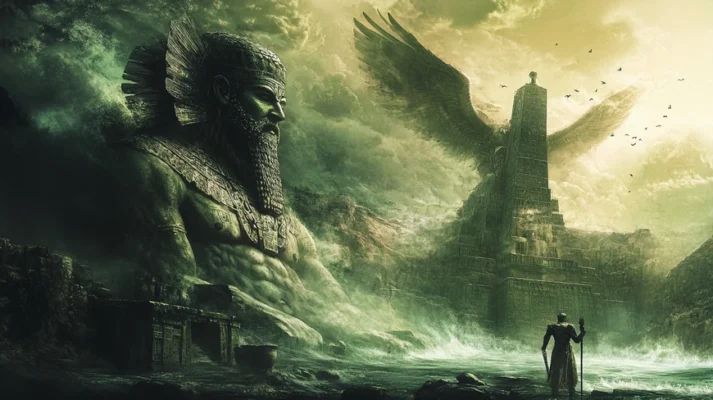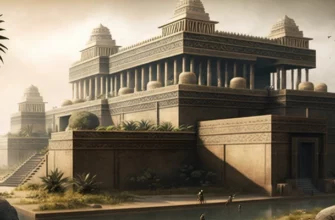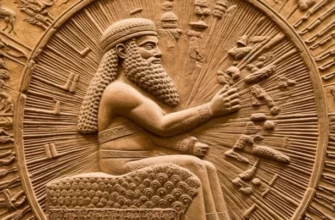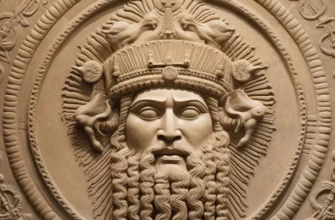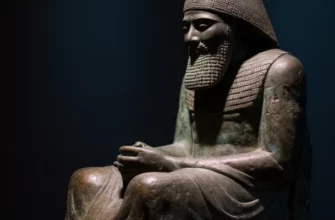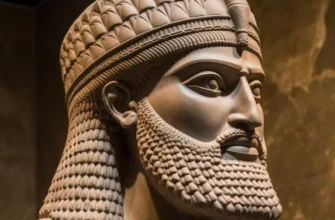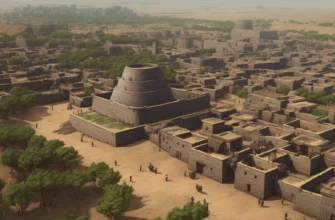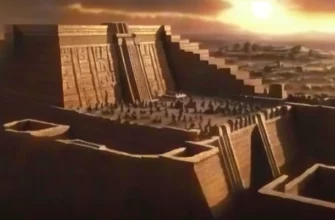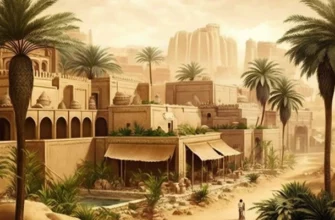The mythology of Ancient Mesopotamia was an important part of the culture of this region, shaping the worldview of its inhabitants. Heroic myths, passed down from generation to generation, reflected people’s struggle with the forces of nature, the gods, and their own destiny.
One of the most famous heroes was Gilgamesh, a demigod and king of Uruk. His adventures are described in detail in the ancient epic “The Epic of Gilgamesh.” Together with his friend Enkidu, he confronted powerful gods and demonic creatures in search of immortality and answers to key questions of human existence. Through his trials, Gilgamesh realizes the value of friendship and the inevitability of death.
Another hero, Lugalbanda, also plays an important role in the myths. He was a ruler and a great warrior who was credited with supernatural abilities. His exploits became a symbol of wisdom and strength.
The heroes of Mesopotamia embodied the ideals of courage, friendship, and the struggle for justice, becoming symbols for future generations. Their legacy influenced the development of literature and culture around the world, leaving an indelible mark on human civilization.
- The significance of myths in Mesopotamian culture
- Main sources and texts of Mesopotamian myths
- Gilgamesh – king and demigod
- Enkidu – a wild warrior and friend of Gilgamesh
- Lugalbanda – legendary ruler and hero
- Themes and motifs of heroic myths
- The struggle with gods and demonic forces
- The influence of myths about heroes on culture and literature
- Conclusion
The significance of myths in Mesopotamian culture
The myths of ancient Mesopotamia played a key role in shaping the worldview and cultural identity of the region. They reflected the attempts of ancient people to understand the world around them, explain natural phenomena, social laws, and the relationships between people and gods. Myths not only served as religious texts, but also functioned as educational and moral guidelines.
The gods and heroes who populated these myths personified the forces of nature, social values, and ideals such as courage, wisdom, and justice. For example, through stories about Gilgamesh and other heroes, people learned about the importance of friendship, fighting evil, and accepting human mortality. In addition, these myths reinforced the religious and political structures of society by explaining why certain rulers had divine origins or power.
Myths also had practical significance: they conveyed knowledge about nature, agriculture, and the cycle of life and death. Thanks to myths, the inhabitants of Mesopotamia felt a connection to divine powers, which strengthened their belief in the special role of their civilization in the universe.
Thus, myths were not just entertainment or a religious element, but the basis for all aspects of life in ancient Mesopotamia, from religious rituals to political institutions and social morality.
Main sources and texts of Mesopotamian myths
The myths of Ancient Mesopotamia have been preserved thanks to numerous written sources created on clay tablets in cuneiform script. The most significant myths and epic works were recorded mainly in the Sumerian, Akkadian, and Babylonian languages. Among the most important sources are:
The Epic of Gilgamesh
This text is the most famous and oldest epic work in world literature. It tells of the exploits of Gilgamesh, a demigod and king of Uruk, who seeks immortality after the death of his friend Enkidu. The work reflects themes of friendship, mortality, and the relationship between humans and gods.
Enuma Elish
Enuma Elish is a Babylonian creation myth that tells of the struggle between the gods Tiamat and Marduk. This epic explains the origin of the cosmos and establishes Marduk’s supremacy as the chief deity of the Babylonian pantheon. Its text was part of New Year’s rituals in Babylon.
The Myth of Atrahasis
This Akkadian myth tells of the creation of humans and the great flood that destroyed humanity for its sins. The main character is Atrahasis, whom the god Enki helps to survive the catastrophe. The myth has similarities to the biblical story of Noah.
Poems about Lugalbanda
Lugalbanda is a hero and ruler of Uruk who, in myths, receives divine help and acquires supernatural abilities. His exploits are described in detail in two poems that recount his travels and adventures, as well as his rise to power.
The Myth of Inanna and Dumuzi
This is a cycle of myths about the Sumerian goddess of fertility and love, Inanna, and her husband, the god Dumuzi. The myths recount their relationship, Dumuzi’s death, and his journey to the underworld. This story symbolizes the natural cycles of life, death, and rebirth.
The Myth of Ninurta
Ninurta was the god of war and agriculture, and his myths depict his victory over the chaotic forces that threatened humanity. These stories emphasized the importance of strength and order in Mesopotamian society.
These texts became a source not only of religious knowledge but also of cultural values passed down through generations. Thanks to these myths, modern researchers are able to gain a deeper understanding of the worldview and beliefs of the inhabitants of Ancient Mesopotamia.
Gilgamesh – king and demigod
Gilgamesh, the legendary king of the city of Uruk, is one of the most famous heroes in the mythology of Ancient Mesopotamia. His image has been preserved in the epic “The Poem of Gilgamesh,” which is the oldest known literary work in the world. Gilgamesh was considered a demigod because he was two-thirds divine and one-third human. His mother, the goddess Ninsun, gave him extraordinary strength and wisdom, but he remained mortal.
Gilgamesh as a ruler
According to legend, Gilgamesh was a powerful king who ruled Uruk around the 27th century BC. At the beginning of the epic, he is described as a cruel ruler who uses his power to oppress his subjects. The people of Uruk appeal to the gods to subdue him, and the gods create Enkidu, a wild man who becomes Gilgamesh’s closest friend and companion.
Feats and the search for immortality
The main part of the epic tells of the adventures of Gilgamesh and Enkidu, their struggles with monsters and gods. Together, they defeat Humbaba, the guardian of the Cedar Forest, and kill the heavenly bull sent by the goddess Ishtar. However, after Enkidu’s death, Gilgamesh deeply mourns the loss of his friend and begins to search for a way to achieve immortality.
This part of the epic reflects man’s eternal desire to overcome death. During his journey, Gilgamesh meets the sage Utnapishtim, who survived the global flood and gained immortality. However, despite all his efforts, Gilgamesh realizes that immortality is unattainable for him. He returns to Uruk with the understanding that a person’s true legacy lies in their deeds and contribution to society.
The symbolic meaning of Gilgamesh
Gilgamesh embodies the archetypal hero: strong, courageous, and charismatic, but also vulnerable, searching for answers to the profound questions of existence. His evolution from a cruel ruler to a wise king symbolizes the process of knowledge and self-improvement. The Epic of Gilgamesh has become not only a literary monument, but also a philosophical work that raises questions about the meaning of life, the nature of human destiny, and the inevitability of death.
Thus, Gilgamesh is not just a legendary ruler, but an archetype of a hero who left a deep mark on world mythology and culture.
Enkidu – a wild warrior and friend of Gilgamesh
Enkidu is one of the central characters of the Mesopotamian epic “The Epic of Gilgamesh.” Created by the gods to counterbalance the powerful Gilgamesh, he plays an important role in the development of the main character and the formation of their strong friendship. His story symbolizes the connection between the natural world and civilization, as well as the evolution of the human soul.
Creation and original state
Enkidu was created from clay by the goddess Aruru on the orders of the supreme gods in response to the complaints of the people of Uruk about Gilgamesh’s cruel rule. At first, he was a wild warrior who lived in nature among animals, unaware of human society. He had extraordinary strength, communicated with animals, and protected them from hunters, living in harmony with nature.
Enkidu’s Civilization
A turning point in Enkidu’s life came when he met Shamhat, a sacred prostitute who used her wisdom and beauty to civilize Enkidu. Through her, he begins to learn human customs, loses his connection with animals, but at the same time becomes part of society. This episode symbolizes the transition from savagery to civilization, as Enkidu acquires the ability to think and feel like a human being.
Friendship with Gilgamesh
After becoming civilized, Enkidu goes to Uruk to challenge Gilgamesh. A fight ensues between them, but as a result, instead of enemies, they become close friends. Their friendship takes center stage in the epic, becoming a source of development for both heroes. Together, they go on adventures, defeat the giant Humbaba, guardian of the Cedar Forest, and kill the heavenly bull sent by the goddess Ishtar.
The Death of Enkidu
After a series of victories, the gods are displeased that the heroes are acting against their will, and they decide to punish one of them with death. Enkidu falls seriously ill and eventually dies, leaving Gilgamesh in deep mourning. His death becomes a key event for Gilgamesh, who begins to understand the transience of life and seek ways to avoid death. The loss of his friend prompts Gilgamesh to search for immortality, which is one of the main themes of the epic.
The symbolism of Enkidu
Enkidu symbolizes the natural, instinctive aspect of human nature, which is eventually subjugated to the social and moral norms of society. His evolution from a wild warrior to a loyal friend of Gilgamesh reflects the transition from the chaos of nature to the orderliness of civilization. In addition, his death reminds us of the inevitability of human destiny and its limitations, regardless of strength or power.
Enkidu is also a symbol of brotherhood and interaction with others, which helps the main character to change and improve. His friendship with Gilgamesh is an important part of the epic, emphasizing the value of relationships, support, and mutual understanding in the human world.
Thus, the image of Enkidu has a deep symbolic meaning, embodying the harmony of nature and civilization, the power of friendship, and the inevitability of death.
Lugalbanda – legendary ruler and hero
Lugalbanda is one of the important figures in the mythology of Ancient Mesopotamia, especially in the Sumerian tradition. He is portrayed as a semi-legendary ruler of the city of Uruk and a great warrior, who is credited with divine origins and supernatural abilities. Lugalbanda is known for his heroic deeds, as well as for being the father of Gilgamesh, which further enhances his significance in myths.
Lugalbanda as a ruler
Lugalbanda is considered one of the early kings of Sumer, particularly the city of Uruk, and was part of the famous list of Sumerian kings. According to this list, he ruled for approximately 1,200 years, reflecting his mythical status. Although there is no concrete historical evidence of his actual existence, his image is deeply rooted in Mesopotamian culture as a symbol of the ideal hero-king.
Poems about Lugalbanda
Lugalbanda is the central figure in two Sumerian poems: “Lugalbanda in the Cave of the Mountain” and “The Return of Lugalbanda.” These works describe his adventures and trials during a military campaign in the land of Aratta, with which Uruk was at war. One day, Lugalbanda falls ill and remains in the mountains, where he finds a cave for shelter. He spends time there alone, prays to the gods, and receives their help to recover.
The second poem describes his incredible journey, during which he gains extraordinary speed and the ability to travel great distances in a short time. In particular, thanks to his prayers to the gods, and especially to the goddess Inanna, he receives a blessing that makes him one of the greatest heroes of his time. He returns to his army and becomes a key participant in the victorious campaign.
Lugalbanda as a god and hero
In the Sumerian tradition, Lugalbanda was also revered as a deity. He acquired the status of a demigod or local guardian spirit who looked after the inhabitants of Uruk. His cult was associated with the ideal of a wise, brave, and just ruler who was revered for his courage, devotion, and support of divine powers.
Lugalbanda and his legacy
Lugalbanda is known not only for his own exploits, but also for being the father of the legendary Gilgamesh. It was believed that it was thanks to Lugalbanda’s divine origin that his son Gilgamesh received a share of his semi-divine power. The image of Lugalbanda in myths emphasizes the hereditary nature of royal power and the divine mandate to rule, which was an important part of Mesopotamian political ideology.
The symbolism of Lugalbanda
The image of Lugalbanda symbolizes the ideal ruler who, thanks to his faith in the gods and their support, is able to overcome superhuman trials and achieve victory in the most difficult situations. He embodies wisdom, strength, loyalty to the gods, and hope for divine assistance, which every righteous ruler can receive.
Thus, Lugalbanda remains an important figure in the myths and culture of Ancient Mesopotamia, representing the ideal of a heroic ruler who, through his faith and courage, reaches unprecedented heights and deserves a place among the gods.
Themes and motifs of heroic myths
The heroic myths of Ancient Mesopotamia reflect the profound religious, social, and philosophical aspects of life in the region. They were not only exciting stories about the exploits of heroes, but also a means of understanding complex human experiences, moral issues, and interactions with the gods and nature. The main themes and motifs of heroic myths can be identified as follows:
The struggle of man against divine forces
One of the main motifs of Mesopotamian myths is the struggle of man against gods or demonic beings. Heroes such as Gilgamesh and Enkidu often face challenges posed by divine forces. For example, Gilgamesh and Enkidu defeat the monster Humbaba, who was sent by the gods to protect the Cedar Forest. These stories emphasize the idea that humans, although subject to the will of the gods, are capable of resisting them in order to achieve great goals.
The search for immortality
The motif of the search for immortality is central to many Mesopotamian myths. It is most vividly revealed in the Epic of Gilgamesh, where the protagonist, after the death of his friend Enkidu, seeks a way to escape his own mortality. Gilgamesh’s quest for immortality symbolizes humanity’s eternal desire to overcome the fear of death and find meaning in life. Although Gilgamesh does not find immortality, he realizes that a person’s legacy lies in their deeds and contributions to society.
Friendship and brotherhood
Friendship is an important theme in heroic myths, especially in the relationship between Gilgamesh and Enkidu. Their friendship not only develops both heroes as individuals, but also symbolizes a deep human connection that helps overcome difficulties and fosters morality. Through their shared exploits, the heroes learn the value of trust, mutual support, and compassion.
The motif of trials
Many Mesopotamian heroic myths are built around the motif of trials that heroes must undergo in order to gain recognition or achieve a certain goal. Lugalbanda, for example, experiences illness, loneliness, and trials in his adventures before receiving the blessing of the gods and becoming a great warrior. Trials symbolize both the physical and spiritual transformation of heroes, making them stronger and wiser.
Interaction with nature
The heroes of Mesopotamian myths often act in natural environments such as forests, mountains, or deserts. Enkidu, who at the beginning of the myth lives in the wild with animals, personifies the primal force of nature, which is later subjugated by civilization. Nature in myths often appears as a powerful force that heroes must control or coexist with.
Royal power and divine mandate
Mesopotamian myths often emphasize that the ruler’s power is of divine origin. Heroes such as Gilgamesh and Lugalbanda are presented not only as warriors but also as divinely chosen kings. This reflects the idea that the king’s power is sacred and that his strength and success depend on his connection with the gods and his fulfillment of their will.
The motif of death and resurrection
Many myths feature the theme of death and its overcoming, as in the case of the hero Dumuzi, husband of the goddess Inanna, who dies and is resurrected every year. This motif embodies the natural cycle of life, death, and rebirth, emphasizing the idea that death is not the end, but part of a continuous process.
Moral responsibility and justice
Myths often emphasize that even heroes and kings must act in accordance with divine and moral justice. Punishment for pride, disobedience, or abuse of power underscores the importance of obeying the laws established by the gods. For example, Enkidu’s death is a consequence of his and Gilgamesh’s defiance of the gods, serving as a lesson for both heroes.
The themes and motifs of the heroic myths of ancient Mesopotamia cover a wide range of issues important to humanity: from personal fate and death to the search for meaning in life, friendship, and power. These myths not only reflected the social and religious norms of the time, but also left an indelible mark on the culture and literature of the entire world, becoming part of the universal human heritage.
The struggle with gods and demonic forces
The struggle of heroes against gods and demonic forces is one of the key themes in the myths of Ancient Mesopotamia. These myths tell of conflicts between human heroes and powerful supernatural beings, reflecting the complex relationship between humans and divine forces. Through these battles, mythological heroes strive to achieve glory, establish order in the world, and earn the respect of the gods.
The Battle of Gilgamesh and Humbaba
One of the most famous episodes of the struggle against demonic forces is the feat of Gilgamesh and his friend Enkidu, who together defeat Humbaba. Humbaba is a terrifying monster who was sent by the god Enlil to guard the sacred Cedar Forest. Gilgamesh sets off there, hoping to gain glory and perform a great feat, despite warnings of danger from gods and men. With the help of the gods and his courage, he defeats Humbaba, thereby violating the will of the god Enlil.
This struggle symbolizes people’s desire to gain control over the forces of nature and defy divine commands in order to achieve greatness. However, feats such as the fight with Humbaba often have consequences — the victory over the demon leads to the gods later punishing Enkidu for his audacity.
The battle with the heavenly bull
Another episode from the myth of Gilgamesh, where the gods oppose the heroes, is the battle with the heavenly bull sent by the goddess Ishtar. Ishtar, angered by Gilgamesh’s rejection of her love, turns to the god Anu to send the heavenly bull to earth to punish the hero. Together with Enkidu, Gilgamesh defeats the bull, thus challenging the gods once again.
This episode shows how heroes can resist divine wrath, but also emphasizes that such actions do not go unpunished. Enkidu’s death is a direct consequence of their feat, reminding us of the dangers of defying the gods.
Battles with demonic creatures
Ancient Mesopotamian myths often feature demonic beings that represent chaos, fear, and destruction. Such beings, such as demons or monsters, embody the elemental forces of nature or invisible threats. Heroes and gods fight them to protect people and restore order. For example, Lugalbanda, another Mesopotamian hero, also faces supernatural trials during his adventures, where he is forced to turn to the gods for help in overcoming difficulties.
The motif of chaos and order
The struggle between gods and demons often symbolizes the conflict between the forces of chaos and order. Although the gods have power over the world, they can sometimes act as destructive forces, especially when heroes violate established laws or order. On the other hand, heroes who fight demons or gods often seek to establish or restore harmony in the world, even if it requires heroic sacrifices on their part.
Lessons in obedience and cooperation with the gods
Although fighting divine forces is a common theme, Mesopotamian myths also emphasize the importance of obedience and cooperation with the gods. Heroes such as Lugalbanda or Gilgamesh eventually realize that despite their strength and courage, they cannot completely resist the will of the gods. Even the greatest heroes need divine blessing to achieve success. Such struggles teach heroes not only to resist the gods, but also to seek harmony with them in order to achieve lasting success.
The struggle with the gods and demonic forces in the myths of ancient Mesopotamia is a central motif that highlights the complex relationships between humans, gods, and supernatural forces. These stories show how human heroes strive to resist higher powers for the sake of glory, honor, or establishing order, but always remain subject to divine will. Such struggles in myths are an expression of man’s desire for self-affirmation and, at the same time, a reminder of his limitations in the face of cosmic forces.
The influence of myths about heroes on culture and literature
The myths of the heroes of Ancient Mesopotamia had a significant impact on culture and literature both in ancient times and in the modern world. They not only shaped the religious and cultural beliefs of the people of Mesopotamia, but also left a deep mark on world cultural heritage, literature, art, and philosophy.
Shaping cultural beliefs and values
Myths about heroes, such as the Epic of Gilgamesh, were not only exciting stories, but also important means of transmitting cultural beliefs and moral norms. They shaped ideas about the ideal hero, ruler, and values that society should honor.
Elements of cultural influence:
Idealization of heroic qualities: Heroes such as Gilgamesh demonstrated courage, strength, wisdom, and the pursuit of immortality, which became a benchmark for future generations.
Moral lessons: Myths often contained lessons about the importance of justice, obedience, and human duties to divine powers, shaping moral and ethical norms.
Influence on literature
The myths of ancient Mesopotamia influenced the development of literature, particularly in the religious and epic genres.
Literary influence:
Epic and poetry: The Epic of Gilgamesh became the basis for epic genres exploring the hero’s journey, the struggle with adversity, and the search for meaning in life. Its influence can be seen in later epic works such as Homer’s “Iliad” and “Odyssey,” which also explore themes of heroism, friendship, and the struggle against fate.
Plot archetypes: Mythological stories about heroes, their struggles with supernatural forces, and their search for immortality have become universal archetypes used in literature across different cultures and eras.
Influence on art
Myths about heroes have also been reflected in art, forming visual images and symbols that have influenced artistic traditions.
Artistic influence:
Iconography and sculpture: Heroic myths were depicted in sculpture and painting, where heroes such as Gilgamesh were portrayed as majestic figures reflecting their epic deeds and divine origins.
Lithography and reliefs: Mesopotamian reliefs and lithographs often depicted scenes from myths, such as battles with monsters or encounters with deities.
Philosophical and psychological influence
Myths about heroes also had a philosophical influence on the understanding of human nature, life, and death.
Philosophical influence:
The search for meaning in life: The search for immortality in the Epic of Gilgamesh reflects profound philosophical questions about the meaning of life and human destiny. These questions continue to be relevant in philosophy and literature to this day.
Psychological Motifs: Myths often explore the inner conflicts of heroes, such as fear of death, doubt, and struggling with one’s own demons, which resonates with contemporary psychological and literary studies.
Impact on popular culture
Myths about heroes have left a significant mark on contemporary popular culture, including literature, cinema, comics, and video games.
Popular culture:
Contemporary adaptations: Elements of heroic myths are often used in contemporary works such as films, TV series, and video games. Heroic characters, motifs of fighting supernatural forces, and the search for immortality have become the basis for the creation of new narratives and characters.
Symbolism and archetypes: Archetypes of heroes and their trials have retained their relevance in popular stories where heroes face supernatural challenges and moral dilemmas.
The myths of the heroes of Ancient Mesopotamia have had a profound influence on culture and literature, shaping ideas about heroism, morality, and divine powers. Their plot elements, symbolism, and philosophical questions remain relevant and inspire contemporary creators in various fields of art and culture.
Conclusion
Mythology plays a key role in shaping the worldview of civilizations, as it determines how a society perceives itself, its nature, and its place in the world. It provides a framework for understanding the cosmos, social relations, and moral norms on which cultural traditions and social institutions are based. Myths, such as Mesopotamian legends about heroes, help shape collective identity, illuminate cultural values, and give meaning to life through religious and moral narratives.
Mythology as a reflection of social and religious beliefs: Myths reflect a civilization’s views on the divine, nature, and humanity’s place in the world. They describe how gods and heroes interact with humanity and what principles govern these interactions.
Shaping cultural traditions: Myths influence cultural traditions, festive rituals, and social norms, establishing models of behavior and moral guidelines that help maintain social harmony and stability.
Heroes as ideals: Heroic figures such as Gilgamesh or Lugalbanda embody ideals of courage, wisdom, and nobility. Their exploits and struggles against supernatural forces symbolize the quest for human perfection and justice.
Religious symbols: In religion, heroes often serve as intermediaries between humans and gods, symbolizing divine intervention or blessing. They serve as examples of how human activity can be directed toward serving divine forces or achieving divine goals.
Artistic representation: In art, heroic myths become a source of inspiration for creators, influencing painting, sculpture, literature, and other art forms. Their images and stories help convey complex emotions, ideas, and cultural messages, preserving the legacy of past eras.
Overall, the role of mythology in shaping the worldview of civilization and the significance of heroes in religion and art underscore how deeply cultural notions of heroism and the divine influence human understanding of the world and themselves. Myths not only shape cultural and moral foundations, but also inspire creativity and spiritual pursuits that continue to influence culture and art to this day.
